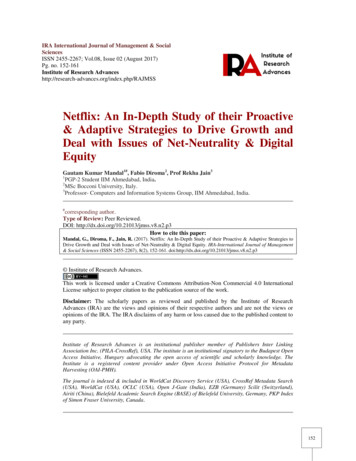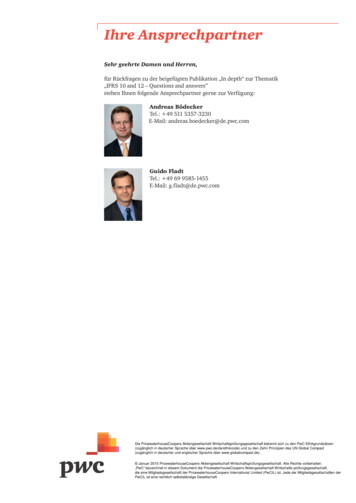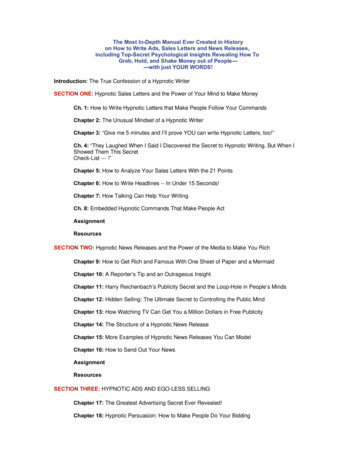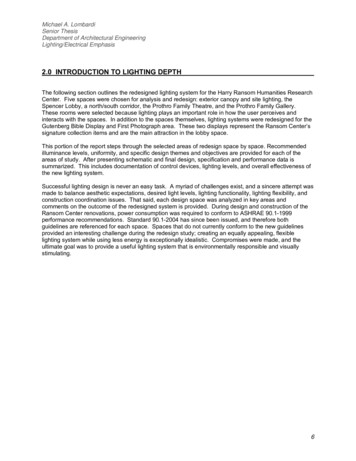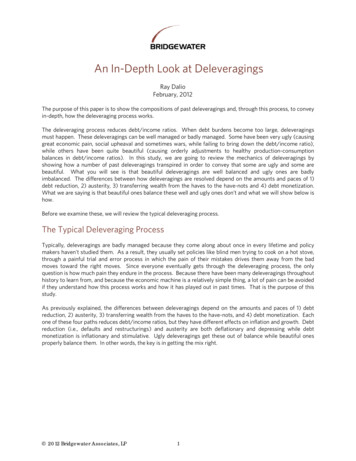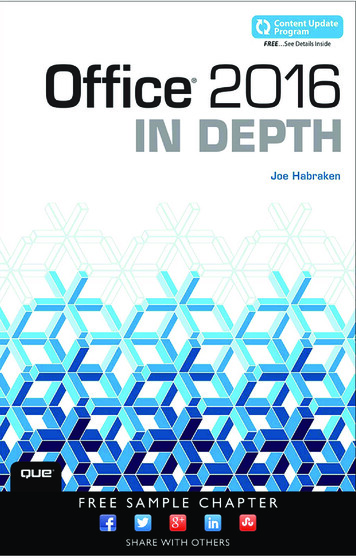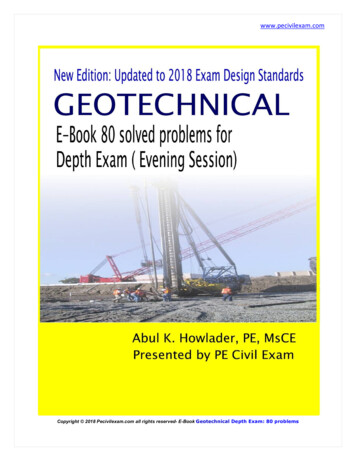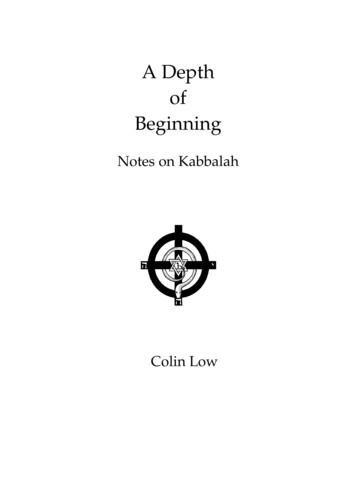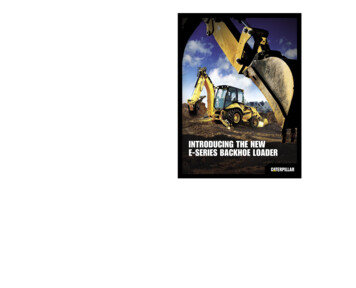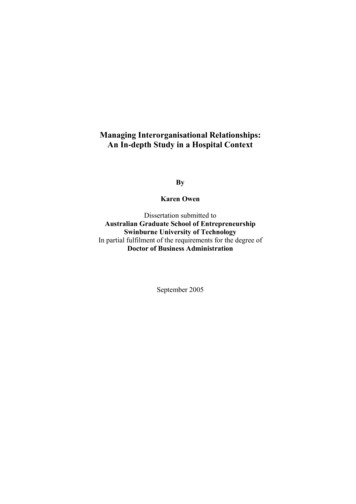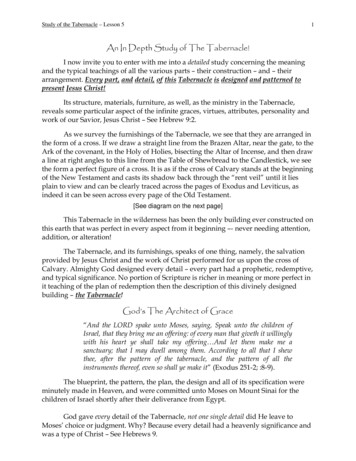
Transcription
Study of the Tabernacle – Lesson 51An In Depth Study of The Tabernacle!I now invite you to enter with me into a detailed study concerning the meaningand the typical teachings of all the various parts – their construction – and – theirarrangement. Every part, and detail, of this Tabernacle is designed and patterned topresent Jesus Christ!Its structure, materials, furniture, as well, as the ministry in the Tabernacle,reveals some particular aspect of the infinite graces, virtues, attributes, personality andwork of our Savior, Jesus Christ – See Hebrew 9:2.As we survey the furnishings of the Tabernacle, we see that they are arranged inthe form of a cross. If we draw a straight line from the Brazen Altar, near the gate, to theArk of the covenant, in the Holy of Holies, bisecting the Altar of Incense, and then drawa line at right angles to this line from the Table of Shewbread to the Candlestick, we seethe form a perfect figure of a cross. It is as if the cross of Calvary stands at the beginningof the New Testament and casts its shadow back through the “rent veil” until it liesplain to view and can be clearly traced across the pages of Exodus and Leviticus, asindeed it can be seen across every page of the Old Testament.[See diagram on the next page]This Tabernacle in the wilderness has been the only building ever constructed onthis earth that was perfect in every aspect from it beginning –- never needing attention,addition, or alteration!The Tabernacle, and its furnishings, speaks of one thing, namely, the salvationprovided by Jesus Christ and the work of Christ performed for us upon the cross ofCalvary. Almighty God designed every detail – every part had a prophetic, redemptive,and typical significance. No portion of Scripture is richer in meaning or more perfect init teaching of the plan of redemption then the description of this divinely designedbuilding – the Tabernacle!God’s The Architect of Grace“And the LORD spake unto Moses, saying, Speak unto the children ofIsrael, that they bring me an offering: of every man that giveth it willinglywith his heart ye shall take my offering And let them make me asanctuary; that I may dwell among them. According to all that I shewthee, after the pattern of the tabernacle, and the pattern of all theinstruments thereof, even so shall ye make it” (Exodus 251-2; :8-9).The blueprint, the pattern, the plan, the design and all of its specification wereminutely made in Heaven, and were committed unto Moses on Mount Sinai for thechildren of Israel shortly after their deliverance from Egypt.God gave every detail of the Tabernacle, not one single detail did He leave toMoses’ choice or judgment. Why? Because every detail had a heavenly significance andwas a type of Christ – See Hebrews 9.
Study of the Tabernacle – Lesson 52Jesus Christ is the perfect, eternal, dwelling place of God. It was after the patternof the Lord Jesus that every part and detail of the Tabernacle was designed.The Tabernacle was enclosed by a wall, or hanging of fine twined linen – 75 feetwide and 150 feet long. It was 7 and ½ feet high, supported by 60 brass pillars havinghooks of silver (Exodus 27:1617).The GateThe gate, 30 feet wide,was on the East side of the courtyard and was beautifullywrought with needlework ofblue, purpose and scarlet of finetwined linen,
Study of the Tabernacle – Lesson 53In this gate we see Christ, whom the New Testament reveals as, “The door” whoprovides a way into the presence of God for all mankind“Jesus said, I am the way, the truth, and the life: no man cometh unto the Father, but by Me’ “(John 14:6).[Also read John 3:14-16; Titus 2:11;1 John 1:2 & Hebrews 2:9]There was no color in the wall that formed the courtyard, however, the gate wasbrightly colored “blue, purple and scarlet of fine twined linen wrought with needle work.”1. “Blue” – is the color of heaven and speaks of Christ’s divinity. Christ was theHeavenly One, veiled in flesh, living among men(John 1:1, 14, 18; 1 Timothy 3:16).2, Purple – is the color of royalty (Judges 8:26) and speaks of Christ’s kinglypower and dignity (Philippians 2:9-11; 1 Timothy 6:15; Revelation 11:15; and 19:11through 20:5).3. Scarlet – is the color ob blood and speaks of Christ’s sacrifice (1 Peter 1:19-20;Acts 2:23 & 4:38).The Pillars of the GateThere were four pillars of the gate to uphold, that which represented Christ Jesus– as the Door, the Way to God – and there are four Gospels setting forth Christ in Hisfour-fold character.MATTHEW – Presents Christ as King, the son of David, son of AbrahamMARK – Presents Christ as the faithful Servant of God (Mark 10:45)LUKE – Presents Christ as the “Son of man” (Luke 19:10 revealing Christ’shumanity as the son of Adam (Luke 3:38)JOHN – Presents Christ as the “Son of God” revealing His Deity (John 1:1-10)There was only one gate, speaking of the only way of access unto God – and so itis today – only ONE way – and that is through Jesus Christ, God’s Son (John 14:6 andActs 4:12)Viewed From The OutsideOne might “live a good life,” however, if he was outside, he was considered, “afaroff” from God – according to Ephesians 2:12-13. As one steps close to the white hangingsof the courtyard that speak of Christ’s righteousness, he see that his righteousness is asfilthy rags.The Wall – or - HangingsSurrounding the Tabernacle was a rectangular shaped courtyard, with only oneentrance (Exodus 27:9-18 & 38:9-20).
Study of the Tabernacle – Lesson 54These hangings created acurtain-wall around a courtyard,150 feet by 75 feet, and were madeof made of fine twined linen hungon pillars of brass, that were set insockets of brass. The hooks at thetop of the pillars were made ofsilver, from thee hooks the whitelinen hangings were fastened. –[See diagram on page 11] –- Therewere 60 of these pillars, and theywere 7 ½ feet high.There was absolutely no wayto enter the courtyard exceptthrough the gate!These linen hangings werea type of the righteousness ofChrist and speak of His sinless,spotless, life (Revelation 19:8). It isthe lack of righteousness thatshuts man from the presence ofGod (Romans 3:10 & 23). Exceptthrough the gate – (Jesus Christ) –God’s presence is surrounded bythis white curtain of “fine twinedlinen,” with only one opening (thegate) and it was too high for manto see over.The penalty was death to all who might seek to enter by some other way thanthe way of God’s provision (Numbers 3:38).THE HIGHT OF THE WALL was so high that none could see over, speaking ofman’s being unable to understand the “things of God” (1 Corinthians 2:9-16). Naturalman is blind to the things of God.THE PILLARS AND SOCKETS were of brass. Brass speaks of the judgment ofGod – (Numbers 21:9 & John 3:14). Judgment falls upon sinners however Jesus Christbore our judgment for sin – (as we will see in the Brazen Altar).As the while linen hangings, reminding us of the righteousness of Christ, wereheld up by the brazen pillars, so, apart from Calvary –- (where sin was judged) –- therecan be no righteousness for man. God’s righteousness to man rests upon Christ’sfinished work of redemption.
Study of the Tabernacle – Lesson 55THE HOOKS WERE OF SILVER and were symbolic of Christ’s atonement. Thepillars were ornamented with silver. Silver was a part of the “redemption” money givenby the children of Israel (Exodus 30:11-16 & 38:25-29). Before an Israelite could be asoldier for God, he had to present unto the Lord “a ransom for his soul.” Before we canbecome a soldier of the Cross, we must be redeemed by the blood of Jesus Christ. TheIsraelite looked up to the beautiful tops of the pillars surrounding the courtyard andsaw what would have reminded him of the atonement money. We look up unto Jesusand see the costly price as a ransom for our souls (1 Peter 1:18-19).What a sight it must have been. It must have been impressive to beholdthose pillars of brass, the white linen hangings fastened to hooks of silver, and theornamental silver crowns on top of those pillars – all glistening in the sunlight!However, how muchmore impressive isChrist – ourRighteousness, ourSin-Bear, and ourRedeemer!The Brazen Altar[Exodus 27:1-8 & 38:1-7]Passing through thegate and entering thecourtyard, the first pieceof furniture thatconfronts us – (also thelargest piece of furnitureof the Tabernacle) – isthe Brazen Altar. TheHebrew word that is translated as “altar” in our Bibles is translated from “mizbrech”meaning, “slaughter place,” and that‘s exactly what the Brazen Altar was for. It was hereclose to the entrance of the Tabernacle courtyard. At this alter the animals wereslaughtered and their blood put on the horns of the altar. No doubt millions of animalswere sacrificed over the centuries. Why were all these animals killed? Would it not havebeen better to give the food to the poor?Without understanding the spiritual significance and prophetic meaning of theBrazen Altar all this slaughtering of animals seems like a vast waste. But, let’s consider .The Brazen Altar was 7 ½ feet square and 4 ¼ feet high. It was made of acaciawood and covered with brass. God was very particular with this altar, just as He waswith every detail of the Tabernacle. He said to Moses in Exodus 27:8 concerning theBrazen Altar, “ as it was showed thee in the mount, so shall they make it.”
Study of the Tabernacle – Lesson 56This massive, strong, altar standing at the entrance of the courtyard was usedmore often than any other furniture of the Tabernacle. For instance, the high priestwould go into the Holy of Holies only once a year to make atonement, other priestswould go into the Holy Place each morning and evening, but at the Brazen Altar peoplecame anytime throughout the day to offer their sacrifices.This whole idea of slaughter, blood, and sacrifice seems morbid, even gruesome,to our modern way of thinking, mainly because it seems natural to our culture to want areligion that doesn’t demand a sacrifice. But the penalty for sin is awesome – requiringthe shedding of blood! However, sacrifice has always been the only way to God, andshould be prominent in the preaching and teaching of the Gospel message.The New Testament makes it very clear that this BrazenAltar of the Tabernacle foreshadowed the Cross of Jesus Christ.Exodus 20:24-25 states, “An altar of earth thou shalt make unto Me, and shalt sacrificethereon thy burnt offerings, and thy peace offerings, thy sheep, and thine oxen: in all placeswhere I record my name I will come unto thee, and I will bless thee. And if thou wilt make me analtar of stone, thou shalt not build it of hewn stone: for if thou lift up thy tool upon it,thou hast polluted it”—showing that the place of sacrifice was prepared by God, nottooled by man. The sacrifice could not be made on anything that was “tooled” by man.In 1 Corinthians 2:2 Paul, the great apostle, states, “I resolved to know nothing whileI was with you except Jesus Christ and Him crucified.” When the sacrifice of Christ on thecross is left out of our preaching and teaching, the Gospel has been gutted, diluted andwatered down. Much of today’s preaching and teaching never mentions the crucifixion,and when that is omitted, everything is lost. There is no forgiveness of sin apart fromsacrifice. We must never forget that! A gospel without the sacrifice made at the cross is nogospel at all.Two materials went into the making of this alter of burnt offering – a verydurable hard wood called, “acacia,” and a complete covering of brass. These brasscovered boards formed a hollow box open at the top and the bottom. This Brazen Altarwas outside the Tabernacle proper, and located in the open courtyard – visible to allwho entered the gate, reminding them that “the wages of sin is death” and “without theshedding of blood there is no remission for sin.”The hard wood of acacia was completelyencased with brass, sealed in, airtight, by thesurrounding brass. It was subjected to theintense hear of continual sacrifices, however, itwas not consumed because, of the fact, that itwas protected in brass. In the same manner, weare subjected to the intense hear of God’s wrathupon our sins – BUT –- “The Lord hath laid onHim [Jesus Christ] the iniquity of us all” (Isaiah53:6).
Study of the Tabernacle – Lesson 57The Brazen Altar was completely square, offering equal opportunity to all. Godis no respecter of persons. It rested on the ground within reach of all – only 4 ½ feethigh.At each corner of the altar there was a horn, or projection, that was to be onepiece with the altar (Exodus 27:2), in order that the innocent victim could be bound(Psalm 118:27). Just as Christ’s cross was stained with blood, these horns were sprinkledwith blood. It was also to these same horns of the Brazen Altar that God provided ameans that the guilty person, fearing for his life, could flee for refuse (1 Kings 1:50-53and 2 Samuel 22:3).Exodus 29:10-12 states, “And thou shalt cause a bullock to bebrought before the tabernacle of the congregation: and Aaron and hissons shall put their hands upon the head of the bullock. And thoushalt kill the bullock before the LORD, by the door of the tabernacle ofthe congregation. And thou shalt take of the blood of the bullock, andput it upon the horns of the altar with thy finger, and pour all theblood beside the bottom of the altar. [Also see Leviticus 8:15].At the offering of the sacrifice at the Brazen Altar an Israelite would bring adesignated animal to die for his sin –- taking his place. He would lay his hands on thehead of the animal and confess his sins, thus transferring his sin to the animal (Leviticus5:5). Then the animal – laden, not with any wrong that he had done but rather, with theperson’s sin – was killed. The priest then caught the blood, sprinkling some of the bloodon the four horns, and pouring the remaining blood at the base of the altar.All of this was only a shadow of the ultimate sacrifice to come. There is no doubtthat after the Last Supper as Jesus walked to the Garden of Gethsemane to be betrayed,He knew that He was about to be sacrificed, and that all the sacrifices on the BrazenAltar were only a picture of His death on the cross. As horrible and nauseating as thesacrifices of the animals in the Tabernacle seem to us, they were all mid compared to thebrutal scourging and the agonizing sacrifice of Christ on the cross.There were “brazen rings in the four corners” of the Brazen Altar through whichthe staves (poles) of acacia wood, overlaid with brass, were put through to carry the altarwhenever the altar was being transported (Numbers 4:13-15).Staves, or poles, that went through rings on the furniture, carried all of thefurniture of the Tabernacle. The rings on the furniture in the courtyard wee made ofbrass, or bronze, and the poles were covered with brass. The rings on the furnitureinside the Tabernacle proper were made of gold like the furniture; also the poles werecovered with gold. Before the furniture was moved the priests would cover it. Everyonewho entered the courtyard was able to see the Brazen Altar and the laver, however,only the priests ever saw the vessels in the Holy Place, and only the high priest ever sawthe Ark of the Covenant in the Holy of Holies and then only once a year on the day ofPassover. Why? The answer is because God was teaching the Israelites to worship theOne of Whom these sacred objects spoke and not the objects themselves.
Study of the Tabernacle – Lesson 58Interestingly, the height of the ”grate” of the Brazen Altar was exactly the sameheight as that of the Mercy Seat in the Holy of Holies, showing a beautiful truth – statedin Psalm 85:10, “Love and faithfulness meet together; righteousness and peace have kissed eachother.” God’s justice demanded the shedding of blood to pay for sin, however, Hismercy provided the sacrifice to put sin away.No Blood – No Access To God!Any Israelite had to sacrifice on this Brazen Altar before he could enter anyfarther into the courtyard, or the Tabernacle. So it is today, it is only by the blood ofJesus Christ that one is entitled to approach the dwelling place of God – (Hebrews 9:22).At this Brazen Altar, the innocent bore the judgment of the guilty – So, today, theinnocent (Jesus Christ) bore the judgment of the guilty – (you and me) – at the altar ofCalvary (Romans 4:25 & Isaiah 53:3-6). At the Brazen Alter God met with man (Exodus29:42-43) so, it is that today, we meet God only at the cross (John 14:6; Acts 4:12 andEphesians 2:12-18.The Brazen Altar was to be continually burning (Leviticus 6:13). God wasteaching Israel that He was always ready to accept their offering. He will never turn apenitent sinner away. Interestingly, there was no chair anywhere in the Tabernacle,showing that the priest’s work was never done. His was a continues job, however,Christ finished the work of redemption, and “sat down” at the right hand of His Father(Psalm 110:1; Hebrews 1:3 and 10:18).Another interesting fact concerning the Brazen Altar – is the fact the“light” for the Golden Candlestick and the “fire” for the Altar ofIncense, was taken from this Brazen Altar, thus showing, in type,that, before one can know Christ as the Light of the world – and theBread of Life – he must, first, meet Him at the foot of the cross.This Brazen Altar cries out about the cross outrage of sin in the eyes of God. Asthe Israelites walked into the courtyard – smelling blood, burning flesh, and death –knowing it was the only way to get right with God –- God was showing them –- (and us)–- that no one should ever take sin lightly!Until one realizes just how horrible all sin is, he will never appreciate God’sprovision for forgiveness. However, not only does the Brazen Altar reveal that sin ismorbid and is hated by God, but also there is another truth that must not be missed.Leviticus 6:12-13 state, “There fire on the altar must be kept burning; it must not go out. Everymorning the priest is to add firewood and arrange the burnt offering The firs must be keptburning on the altar continuously, it must not go out.”The was to burn day and night, teaching that God was always ready to accepttheir offering for sins, that He was always ready and anxious to forgive, and that Hewould never turn away a repentant sinner. Christians today have those same
Study of the Tabernacle – Lesson 59assurances found in the promises of 1 John 1:9, “If we confess our sins, He is faithful andjust and will forgive us our sins and purify us from all unrighteousness.”Now that we have considered the brazen Altar itself, lets look at . . .The Accessories of the Brazen AltarThere were several articles that went with the brazen Altar. Exodus 27:3 states,“And thou shalt make his –- [referring to the Brazen Altar – as if it had personality] –- pans toreceive his ashes, and his shovels, and his basons, and his flesh-hooks, and his fire-pans: all thevessels thereof thou shalt make of brass.”Five accessories were used to serve at the Brazen Altar – All made of brass o0rcopper:1. The pans were used to carry out the ashes2. The shovels were used for picking up the ashes and for tending the fire3. The basons held the blood of the sacrificial animal4. The flesh-hooks were for keeping the sacrifices in the middle of the fire so itwould be totally consumed5. The fire-pans, or censers, were used to carry fire from the Brazen Alta to theAlter of Altar of Incense in the Holy Place. The fire for the gold-covered Altarof Incense could only be taken from this one source and brought to the veilbefore the presence of the Lord.[In Leviticus 10:1-3 we find an account of Nadab and Abihuwho failed to follow this procedure.]Before the death of Christ on the cross, God refused to be approached other thanby the means of the Brazen Alter of sacrifice. Likewise, today He refuses to beapproached except by the way of the cross. Leviticus 17:11 states, “For the life of acreature is in the blood, and I have given it to you to make atonement for yourselves on the altar– [the Brazen Altar] –- it is the blood that makes atonement for one’s lie.” The New Testamentequivalent of this truth states in Hebrews 9:22, “Without the shedding of blood there is nofiorgiveness.”
Study of the Tabernacle – Lesson 5 5 THE HOOKS WERE OF SILVER and were symbolic of Christ’s atonement. The pillars were ornamented with silver. Silver was a part of the “redemption” money given by
